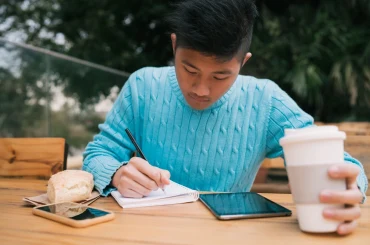
- 357 Lê Hồng Phong, P.2, Q.10, TP.HCM
- Hotline 1: 1900 7060
Hotline 2: (028) 3622 8849
Bài Mẫu IELTS Writing Task 1: Life Cycle

Sample Answer 1:
The diagrams illustrate the stages in the life of a silkworm and the process of producing silk cloth.
There are four main stages in the life cycle of the silkworm, from eggs to adult moth. The process of silk cloth production involves six steps, from silkworm cocoon to silk material.
At the first stage in the life cycle of a silkworm, the moth lays its eggs. Around ten days later, silkworm larvae hatch from the eggs; these larvae feed on mulberry leaves. Then, after four to six weeks, the larvae become covered in silk thread, and it takes between three and eight days for a full cocoon to be produced.
For silk cloth production, a cocoon is first selected and then boiled in water. After boiling, the silk thread that makes up the cocoon is unwound, and then several strands of thread are twisted together. At the fifth and sixth stages in the process, the thread can either be dyed and then woven into silk fabric, or it can be woven first and then dyed subsequently.
Sample Answer 2:
The given pictorial show the life cycle of the silkworm and also shows the processes of silk cloth productions.
The life cycle of a silkworm begins from the eggs laid by the mother worm and from these eggs the silkworm larvae are generated after 10 days. The silkworm larva usually eats leaves like mulberry leaves and completes the second stage of the life cycle in 4-6 weeks. In their third stage, they create silk thread shells and remain there for another 3 to 8 days and then create an oval cocoon. The cocoon stage lasts for around 16 days and they become moth in the final stage. With time the moths become grown-up and recycle the processes again.
The second picture describes the processes of the silk cloth production which have more than 5 stages. In the initial stage, the silk thread shells of the silkworm are selected and then boiled in the next stage. After boiling in water the threads are unwinded and they are usually 300 to 900 meter long. Then these are twisted and dyed and finally, those are weaved to silks. The twisting, dying, weaving and then dying again the process is done more than once as per necessary to produce fine quality silks.
THƯ VIỆN LIÊN QUAN

Hãy cùng tìm hiểu về cấu trúc đề IELTS Writing task 1 với Phuong Nam Education và các dạng đề của phần thi này qua bài viết sau. Khi ôn luyện...

Để viết một Discussion Essay hiệu quả, người học cần phải hiểu được tính chất, bố cục của dạng đề này và có một chiến lược làm bài cho riêng mình....

Để viết một Argumentative Essay hiệu quả, người học cần phải hiểu được tính chất, bố cục của dạng đề này và có một chiến lược làm bài cho riêng...

Bài viết cung cấp chon đọc giả Bài mẫu Writing task 2 - Chủ đề: Advertising và phân tích từ vựng
Hoặc gọi ngay cho chúng tôi:
1900 7060
 | Chính sách bảo mật thông tin | Hình thức thanh toán | Quy định chung
| Chính sách bảo mật thông tin | Hình thức thanh toán | Quy định chung
Giấy chứng nhận đăng ký doanh nghiệp số 0310635296 do Sở Kế hoạch và Đầu tư TPHCM cấp.
Giấy Phép hoạt động trung tâm ngoại ngữ số 3068/QĐ-GDĐT-TC do Sở Giáo Dục và Đào Tạo TPHCM cấp